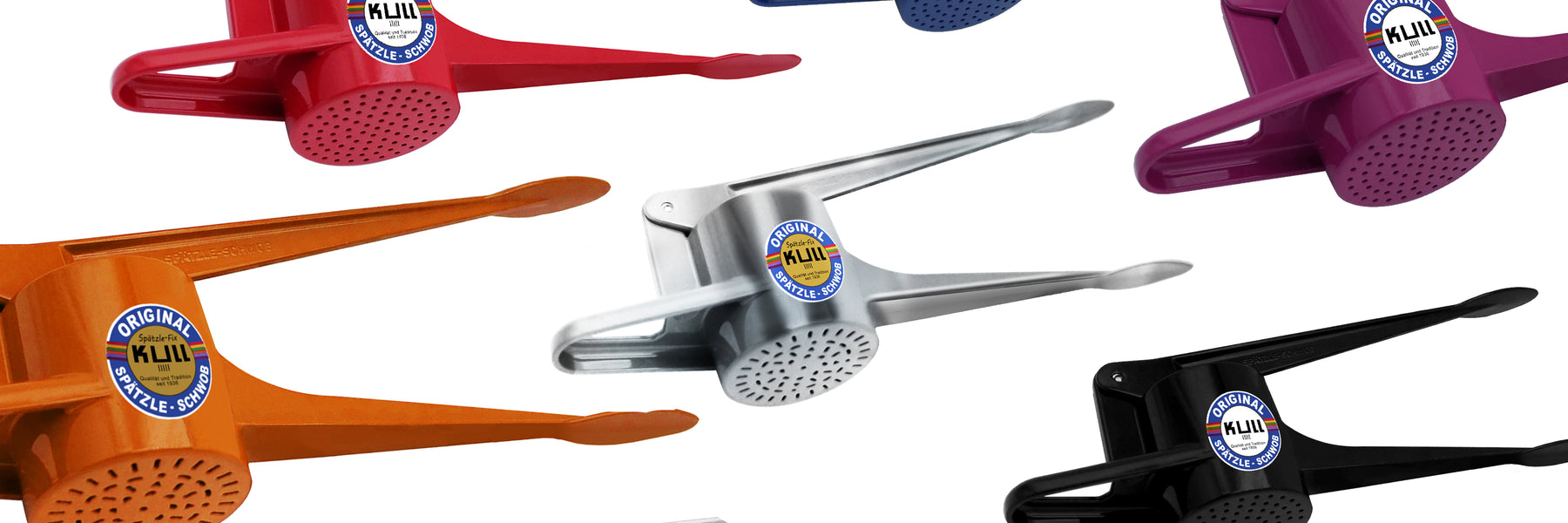
The History of Kull Spätzle-Schwob - A Swabian Cult Product since 1939
When it comes to Swabian specialties, Spätzle are indispensable. However, the preparation of these delicious pasta dishes was not always easy and time-

consuming. Fortunately, there was a philanthropist and inventor named Robert Kull who revolutionized home Spätzle production 70 years ago. With his invention, the Spätzle press, he made people's lives easier and created a cult item - the Kull Spätzle-Schwob.
Robert Kull: From "Signierschablonen" to Spätzle-Schwob:
Robert Kull, a machine fitter from Cannstatt (District of Stuttgart), began his career by making signature templates and branding irons. But his daily life was unimaginable without Spätzle. His wife Pauline scraped large quantities of Spätzle by hand every day, which prompted Robert Kull to search for a solution. Eventually, he developed a brilliant contraption: The Spätzle dough is pressed through a pot with holes using a stamp - the "Spätzles-Schwob" was born.
The Rise of the Spätzle-Schwob
In 1936, Robert Kull started the production of his groundbreaking device inStuttgart. Although he immediately applied for a patent, it took three years for the bureaucracy of the German Reich to grant it to him. However, the press quickly gained popularity and allowed people to prepare Württemberg specialties outside the Swabian cultural circle. The machine even became a great success internationally.

Surviving Hardship: The Spätzle-Schwob During and After the War
The Spätzle-Schwob remained Robert Kull's most famous product, even though his factory was bombed in 1944. After the war, the focus shifted to cooking pots and roasters, while Spätzle machines were in demand as barter items on the black market. Robert Kull helped hungry war returnees to ease their survival. In 1953, he moved his business to Geradstetten in the Remstal and eventually handed it over to his grandson Max Mauz.
Max Mauz: Continuing the Legacy of Innovation
Max Mauz continued his grandfather's legacy and brought further innovations to the production of the Spätzle-Schwob. He developed the Spätzle-Fix with irregularly shaped holes to make the Spätzle look even more authentic. He also improved the machine's cleaning possibilities with a detachable lever. For those who still valued traditional manual work, Max Mauz also produced Spätzle boards and scrapers made of stainless steel.
The Kull Spätzle-Schwob Today: A Swabian Classic
Today, the Kull Spätzle-Schwob is a classic and cult item in Swabian cuisine. Its solid yet lightweight aluminum die-cast housing, removable stamp, and high-quality craftsmanship make it the perfect companion for preparing Spätzle. The company attaches great importance to its Swabian origin and still carries out the final assembly in the Remstal.

Julius Basso: A Passionate Advocate and Representative

Our friend Julius Basso is a passionate advocate of Swabian cuisine and recognized the potential of Kull Spätzle presses early on to facilitate the preparation of Spätzle. As an external representative, he was responsible for contacting retailers, restaurants, and other potential customers to familiarize them with the advantages and quality of Kull Spätzle presses.
Honoring Julius Basso's Contribution
We would like to thank Julius Basso for his contribution and support by providing us with the very first industrially manufactured Spätzle press for this blog entry, according to him, "The Number 1." His long-standing collaboration as a seller with Kull Spätzle presses and his commitment to Swabian cuisine have contributed to the continued success of this traditional product.

